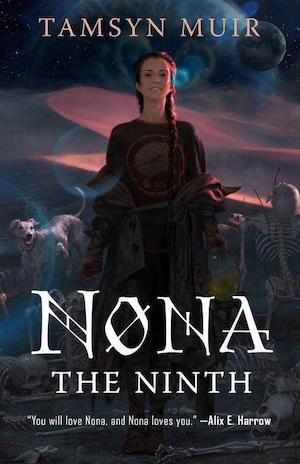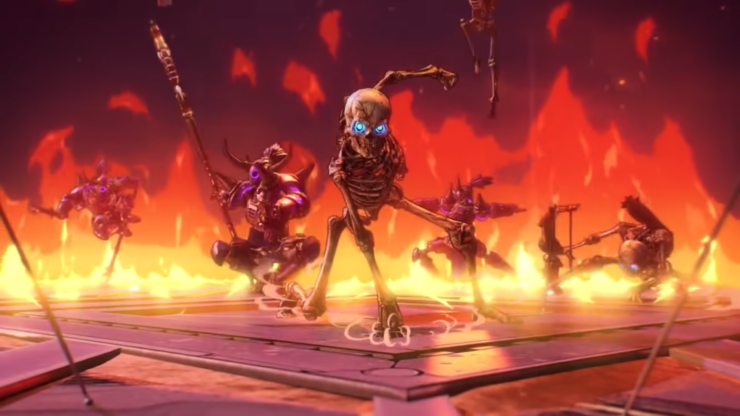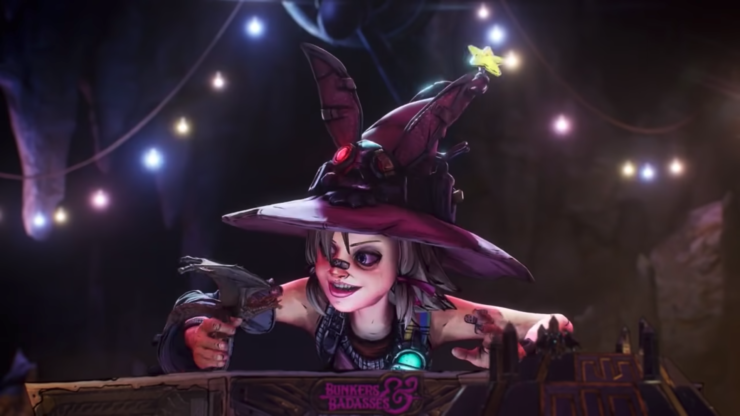We’ve come a long way from the stiff dialogue and matter-of-fact storytelling pervading the early days of fantasy and science fiction. Gone are the days of “Ho there, what business!” and hundred-plus page stretches of travel described in excruciatingly minute detail. Today, it’s not difficult to find quests and adventures of all types told with unparalleled speed and wit, and the genre resounds with talented voices that aren’t afraid to test the limits of sci-fi and fantasy storytelling. Look to The Lies of Locke Lamora or Murderbot, both of which reshaped the borders of their respective genres to inject new life into existing tropes. We exist in a world intent on shattering conventions and expanding the scope of the stories we love. The result? Truly unique fantasy and science fiction, in many different formats and media.
One such story comes in the form of a recently released video game: Gearbox’s Tiny Tina’s Wonderlands. It’d be easy to write the game off as a cash grab, spinning off the wildly popular Borderlands franchise. But to do so would be a massive disservice because Tiny Tina’s Wonderlands makes a thrilling playground of its fantasy world, completely lets loose, and isn’t afraid to have fun.
Fantasy and sci-fi, of course, are inherently fun. Even the serious-leaning stories that molded the genre into the cultural force it is today have moments of joy and laughter (even if the humor can be a little dark, depending on the author). Despite the inherent humor and whimsy of a lot of SFF, though, it feels oddly rare to find an experience so rooted in ridiculousness that you can’t help but laugh. Tiny Tina’s Wonderlands has no qualms about reveling in the ridiculous, making it a prime conduit for fantasy and sci-fi fans to really let loose and relish the hilarity within, helped along by a cast of voice actors that includes comedians Will Arnett, Wanda Sykes, and Andy Samberg.
https://www.youtube.com/watch?v=3gJgj2ngCyA
Tiny Tina’s Wonderlands takes the form of a “Bunkers & Badasses” campaign run by a raving lunatic (the eponymous Tina, the 13-year-old demolitions expert from the Borderlands series of games). The D&D analog serves as the frame narrative; the in-game characters are playing from a defunct spaceship, presumably awaiting recovery as they drift in space.
Players take the role of a Fatemaker, choosing a class and dropping into the wacky world of Tina’s creation. The game’s playful tone is evident as early as the character creation screen, where the class names—Brr-Zerker, Spellshot, Clawbringer, Spore Warden, and Stabbomancer—offer silly plays on popular class archetypes from role-playing games. The alluring wordplay of Brr-Zerker and Stabbomancer were tempting, but I ended up choosing the Clawbringer—I couldn’t pass up the opportunity to welcome a wyvern companion into my ranks.
Buy the Book


Nona the Ninth
Character creation? Check. Brambly the Clawbringer was then dropped into an off-the-rails fantasy adventure that has yet to let up. Tiny Tina’s Wonderlands simultaneously subverts and pays homage to the fantasy genre. The game brims with gut-splitting humor and awe-inspiring set pieces, both of which feel utterly at home in its hybrid fantasy-sci-fi setting.
Tina herself drives much of the wackiness home, occasionally reminding the player exactly who’s in charge when she steps in to reverse an event or simply narrate a barrier out of existence. Nothing is sacred in Tiny Tina’s Wonderlands, because that’s not the point. Instead, the game wants players to have unfettered fantasy fun above all else, and it delivers on this premise.
Look to the overworld, which allows players to travel between major game hubs. Player avatars become bobblehead-esque figures with overly large craniums and tiny bodies. Wandering around the overworld is entertaining in itself, filled with Random Encounters as enemies pop up in the tall grass. NPCs litter the world, too, alongside bottlecap bridges and improvised tabletop gameplay materials. The Tiny Tina’s Wonderlands overworld is basically a love letter to D&D with a fresh dose of fantasy fun sprinkled in.
Zoom in on the core gameplay, though, and you’ll see just how freewheeling Tiny Tina’s Wonderlands can be. It feels very much like a Borderlands game, though it engages with the freedom provided by its fantasy-heavy premise to marvelous effect. The arsenal spans thousands of gun variants, with in-game manufacturers favoring specific features. Spells replace grenades, and they range from sensible (shoot a pillar of flame at your enemy) to gloriously ridiculous (polymorph your enemy into a sheep). Tiny Tina’s Wonderlands is a first-person looter-shooter from head to toe, but it’s fueled entirely by the humorous whimsy so prevalent in fantasy and sci-fi. It’s hard to play any stretch of the game without laughing.
All this is fine and dandy, but I haven’t even touched on the missions. They are the game’s crowning achievement, turning longtime fantasy tropes on their heads and offering quests that genuinely piqued my party’s interest without making us want to skip through the intro conversation. One side quest early on had us fetching stinky goblin loincloths. Another, further down that same questline, required us to acquire a special dye to paint the goblins with a vibrant polka-dot pattern. Though inconsequential in the long term, the simple fetch quests held our interest to the point where we went about the tasks with gusto.

But one early-game quest stood out above the rest: Goblins Tired of Forced Oppression, or GTFO for short. The quest-giver, Jar, needs the player’s help to unionize goblins and end the forced labor they currently endure. The mission asks players to hang posters encouraging goblin workers to join with Jar, in between bouts with enemies and bosses that litter the area. Then, Jar asks for help freeing political prisoners nearby to complete the quest.
GTFO provides a perfect example of Tiny Tina’s Wonderlands’ willingness to overlook the tried-and-true fantasy tropes. In any other game or story, it’d be easy to shunt goblins into the enemy role, sending players to destroy them en masse. But Tiny Tina’s Wonderlands takes a different perspective. It keeps the mission feeling fresh. It keeps the goal focused in the player’s mind. Instead of following an arrow, shooting some stuff, and collecting loot, players are bound to become invested in the story, paying closer attention to the quest-giver and the goings-on in the vast fantasy world at hand.
Oh, and maybe I should mention: I’m only about 15 hours into my Tiny Tina’s Wonderlands playthrough, at this point. I’ve launched myself from one region to the next using a catapult. I’ve followed a rainbow unicorn to the ends of the earth. I’ve faced off with a wizard who loves to teleport and tease me whenever he reappears out of my reach. I’ve met a bard deep in the mushroom-ruled forests. There are dozens of hours of fantasy fun to be had in Tiny Tina’s Wonderlands, and I’ve only scratched the surface.
Tiny Tina’s Wonderlands is far from the first story to explore the boundaries of the sci-fi and fantasy genre. But it’s certainly one of the more impressive attempts in recent memory. Come for the polished shoot ‘n’ loot gameplay, stay for the surprising, refreshing, genuinely entertaining fantasy fodder within.
Do you have a favorite story, game, movie, or show that subverts the typical SFF tropes to create something new? Let me know in the comments!
Cole Rush writes words. A lot of them. For the most part, you can find those words at The Quill To Live or on Twitter @ColeRush1. He voraciously reads epic fantasy and science-fiction, seeking out stories of gargantuan proportions and devouring them with a bookwormish fervor. His favorite books are: The Divine Cities Series by Robert Jackson Bennett, The Long Way To A Small, Angry Planet by Becky Chambers, and The House in the Cerulean Sea by TJ Klune.










